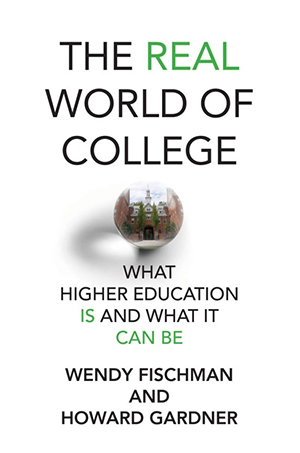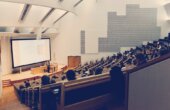Has Higher Education in the United States Lost Its Way?

For their book “The Real World of College,” Wendy Fischman and Howard Gardner, along with their research team, spent five years visiting 10 disparate campuses, carrying out over 2,000 intensive interviews with students, alumni, faculty, administrators, parents, trustees, and others. What they found challenged characterizations in the media: Students are not preoccupied by political correctness, free speech, or even the cost of college. They are most concerned about their GPA and their resumes; they see jobs and earning potential as more important than learning. Many say they face mental health challenges, fear that they don’t belong, and feel a deep sense of alienation.

The authors’ regretful conclusion: Many, perhaps most, U.S. colleges have lost — or lost sight of — their principal reason for being. “By virtue of the many activities available on campus, motivations for attending college, often unhelpful expectations generated in secondary school, and the myriad of mixed messages on traditional media and social media,” the authors write in the book’s introduction, “colleges are overwhelmed by mission sprawl.” They contend that to remedy this schools must focus sharply on their core educational mission. We asked Fischman and Gardner, both recognized authorities on education and learning, to tell us more about their exhaustive study and what postsecondary education reform in America might look like.
How did you decide to embark on this comprehensive study of the state of higher education?
For a quarter of a century, both of us have been studying the nature of good work (see thegoodproject.org). When we worked with young people, we found that they typically knew what good work was and admired it from afar. But they felt that they could not afford to do good work, because if they behaved properly, they would be scooped by peers who cut corners. Good work was “for later” in life, after success had been assured.
Of course, this disturbed us. And so, we began to work with college students in the Northeast, with various kinds of interventions. We realized that we needed to do this in a far more systematic way, so we embarked on our ambitious study of American colleges — interviewing in-depth over 2,000 individuals at 10 schools. The campuses we visited range from highly selective private schools to less selective public institutions; they differ in terms of region, demography, and declared missions. It took us 10 years, with the help of a few dozen research assistants, to design, carry out, analyze the data, and write up our findings.
What was the most unexpected thing you learned?
There are a few things. First, across disparate campuses, students are far more similar than we had anticipated. They have similar goals and concerns and even use the same words to describe their experiences! We find few, if any, differences based on background or where they currently attend school.
Second, what you read about in the news is not on the minds of most students — free speech, political correctness, and even the cost of college rarely came up. Rather it was issues of mental health, and a sense of belonging or alienation. The exceptions to the point about free speech occurred right before or after a controversial speaker came to campus. We have continued to interview students after our study was completed — and it is true that at select schools, students sometimes feel silenced, afraid to say what they think. They are afraid that they will be misinterpreted, judged, and cancelled. We find that on the whole, students are uncomfortable discussing ethical issues.
In terms of the cost of college, this rarely came up organically as a topic of concern among students (adults assume that this is more of a concern for students). The cost of college was indeed a determining factor for students in deciding where to enroll (once they received their acceptances and learned about financial assistance decisions), but once they were in college, it did not seem to come up much for them. The only exception is when some students talked about tension with students from different socioeconomic backgrounds.
Another surprising finding was the egocentrism of students — our students use the world “I” and “me” 11 times as much as “we,” “us,” or “our.”
Another surprising finding was the egocentrism of students — our students use the world “I” and “me” 11 times as much as “we,” “us,” or “our.” We believe that this egocentric focus may be particularly characteristic of U.S. students, and during this period of time. We find this worrisome.
Lastly: the misalignment between students and parents on the one hand, and faculty and administrators on the other. It is striking that students are mostly in agreement with the adults with whom most of them do not see on a daily basis, whereas they differ greatly from those with whom they are in contact. For example: the bulk of students are transactional (they see college as a means to an end) while almost all faculty and administrators are transformational (they see college as an opportunity to reflect, grow, and possibly change). This comes up as a major throughline throughout the study.
In your book, you propose the concept and metric of “higher education capital.” Can you describe what the term means and how it was useful for your study?
Higher education capital (HEDCAP) is the term we use to describe a student’s ability to attend, analyze, reflect, connect, and communicate on issues of importance. For example, if you are sitting next to a stranger on a train or bus and strike up an hour-long conversation with this person about almost any topic (a movie, book), you will have a sense of one’s ability to ask good questions, connect the dots, bring in other perspectives, ask for clarifications, articulate one’s own viewpoints. This is HEDCAP.
We developed a way to measure HEDCAP by a simple scoring system in which participants were scored as having a little HEDCAP (since we couldn’t prove that someone didn’t have any), some HEDCAP, or a lot of HEDCAP. We scored students and alums in two ways: First, we de-identified student and alum transcripts to “blind score” the HEDCAP of participants’ responses to each of seven specific questions — questions we determined would elicit substantive responses. Second, we gave each student and alum a holistic HEDCAP score — based on an entire interview (not specific questions). We found that these two methods correlated well.
HEDCAP is important to our study because we can use it to determine the extent to which one’s intellectual capital might “increase,” “decrease,” or stay the same over the course of college and beyond (since we scored alums). We can also correlate HEDCAP with other measures, for example, mental models and belonging. Developing one’s HEDCAP over time ought to be the major purpose of college.
Your study focuses heavily on nonvocational higher education, a sector associated with general education and the liberal arts. Why did you choose to focus on these schools, and what is the use of this type of education in the 21st century?
The genius of American education has been the college — an institution which purports to present a broad general education, giving students the knowledge and understandings that will serve them no matter what work they do, where they live, etc. This form of education is vital for any democratic society. Alas, this form of education is in jeopardy in this country, largely because of the signals given by many parents, many teachers, and the broader society. We believe it would be tragic should this tradition be undermined.
We have no objection to vocational education and in fact we include one supposedly vocational school in our sample, The Olin College of Engineering. As one student there told us: “I am getting the best of both worlds, a liberal arts education and an engineering degree.” That’s very unusual. However, if a student chooses a liberal arts and science school or program, they ought not to be focused simply on jobs or vocation. Note that all over the world, other countries are trying to implement liberal arts education. They admire what our country risks losing.
You propose two general approaches to improve nonvocational higher education: onboarding and intertwining. Can you describe these terms?
Onboarding is the concept we use to describe how to get all students aligned with the goal of the college or university, higher learning. From the first interaction on campus — whether this be at an admissions tour, orientation, or the first day of class, the mission of the institution needs to be clearly conveyed. Too often, students (and their parents) know more about internships, jobs after college, study abroad programs, residence and dining halls, and the gyms on campus.
Intertwining is the concept that if a school has a secondary mission — such as civics, religion, ethics or even work (like at Northeastern University or Berea College) — that this needs to be integrated into the academic program for students. If it is separate, it will seem “extra” and not necessary or important. To have effective higher education, we need students who understand the mission; faculty, staff, and administrators who model the mission; and institutions that reflect the mission.
What are the biggest challenges facing schools and students today?
Unfortunately, there are many challenges. For students, the two main challenges they speak about are mental health (now deemed a “crisis”) and lack of belonging.
We also see other challenges for students, mainly the preoccupation with achieving “external measures of success” (grades, acceptances, jobs) over learning. In other words, students feel it is more important to get an A or to build their resume to get a particular job than it is to be exposed to new, different, or challenging content material — or even to do their own work (cheating is rampant on the college campus and by all accounts has intensified post-COVID because of online tests and exams).
This “uber transactionality” has been instilled in students early on their education. Therefore, some of the biggest challenges colleges face is not with just college itself, but also with the high schools and parents where these students come from.
Students feel it is more important to get an A or to build their resume to get a particular job than it is to be exposed to new, different, or challenging content material.
In terms of the institution, challenges include: misalignment between faculty and administrators and the “customer,” prioritizing the mission of higher education (and not the fancy buildings or athletic departments on campus), and justifying the value of higher education to students and their parents who worry about their “return on investment” (the number of college students is declining, as is the number of male students).
The pandemic has dramatically disrupted schools as much as any other part of our society. Has it changed your assessment of higher education or offered any insight into its future?
In one way we were very fortunate. Our data collection was completed in 2018, well before the onset of the pandemic. In 2020 and 2021 we could not have carried out the many hundreds of interviews in person, on campus, in a realistic setting. We all know that the pandemic has disrupted all forms of education. It’s been hard on everyone — thus the increase in mental health problems for teachers as well as students continues.
But one important blessing, in our view, is that the pandemic has forced every institution and every profession to consider it core mission, its core values, its essentials — the features and objectives that cannot and should not be scuttled. Two years after the pandemic, we feel more strongly than ever that we have lived up to the message of our book’s subtitle: What it is, What it can be.
Wendy Fischman is a Project Director at the Harvard Graduate School of Education and lead author of “Making Good: How Young People Cope with Moral Dilemmas at Work.” She is coauthor (with Howard Gardner) of “The Real World of College: What Higher Education Is and What It Can Be.”
Howard Gardner is John H. and Elisabeth A. Hobbs Research Professor of Cognition and Education at the Harvard Graduate School of Education and the author of “A Synthesizing Mind: A Memoir from the Creator of Multiple Intelligences Theory” and many other books.



